Engine
Pre-takeoff checklist
Neither am I. Nor am I trying to catch you being wrong or anything. Just trying to understand this discussion best.
Certainly something I can stand to learn.
My logic here is given the understanding that the oil pump will really not pump oil until we actually get ignition - or close to there - I suspect that turning the prop by hand will cause the same wear/tear/friction OR less than that caused by the starter. The way I understand it when the start is engaged the oil pump is not doing much at those low RPM's.
Feel free to tell me I am completely wrong. There is always the very high probability I am.
Certainly something I can stand to learn.
My logic here is given the understanding that the oil pump will really not pump oil until we actually get ignition - or close to there - I suspect that turning the prop by hand will cause the same wear/tear/friction OR less than that caused by the starter. The way I understand it when the start is engaged the oil pump is not doing much at those low RPM's.
Feel free to tell me I am completely wrong. There is always the very high probability I am.


